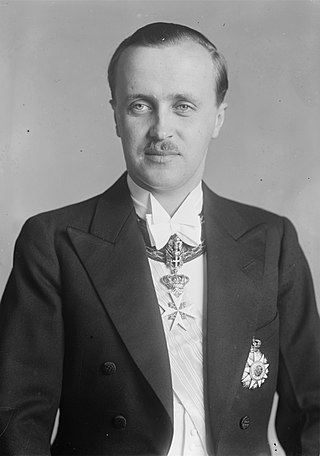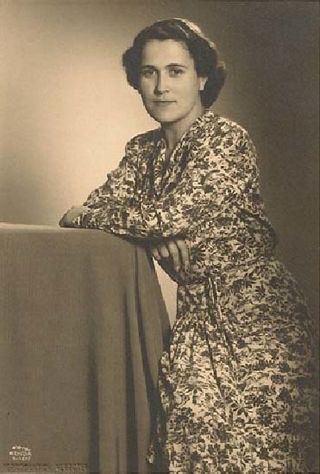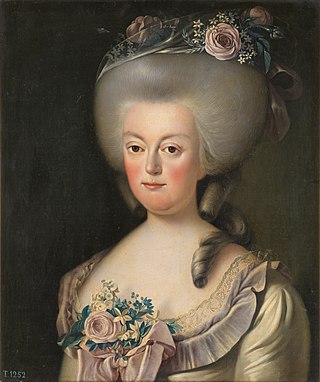
The Most Serene House of Braganza, also known as the Brigantine dynasty, is a dynasty of emperors, kings, princes, and dukes of Portuguese origin which reigned in Europe and the Americas.

Maria Pia de Saxe-Coburgo e Bragança, also known by her literary pseudonym Hilda de Toledano, was a Portuguese writer and journalist who claimed to be the illegitimate daughter of King Carlos I of Portugal. From 1932 she also claimed the right to the title of Duchess of Braganza and to be the rightful heiress to the throne of Portugal.
Prince of Beira is a title traditionally granted to the heir apparent to the throne of Portugal. The title's original use that it be granted on the eldest daughter of the reigning monarch of Portugal. Tied with the title of Prince of Beira, is Duke of Barcelos, as heir to the Duke of Braganza and Prince of Brazil. The title's name has its origins in the Beira province in central Portugal.

Infanta Ana de Jesus Maria of Braganza was a Portuguese infanta and youngest daughter of King John VI and his wife, Carlota Joaquina of Spain.

DomDuarte Nuno, Duke of Braganza was the claimant to the defunct Portuguese throne, as both the Miguelist successor of his father, Miguel Januário, Duke of Braganza, and later as the head of the only Brigantine house, after the death of the last ruling Braganza, King Manuel II of Portugal. In 1952, when the Portuguese Laws of Banishment were repealed, the Duke moved his family to Portugal, thus returning the Miguelist Braganzas to their homeland and becoming the first of the former Portuguese royal dynasty to live in Portugal since the abolition of the monarchy in 1910.

Duarte, Duke of Guimarães was a Portuguese infante (prince); the sixth son of King Manuel I of Portugal and his wife Maria of Aragon.

Infanta Maria Francisca of Braganza ; full name: Maria Francisca de Assis da Maternidade Xavier de Paula e de Alcântara Antónia Joaquina Gonzaga Carlota Mónica Senhorinha Sotera e Caia de Bourbon e Bragança; 22 April 1800 – 4 September 1834) was a Portuguese infanta (princess) daughter of King John VI of Portugal and his spouse Carlota Joaquina of Spain.

Infanta Isabel Maria of Braganza was a Portuguese infanta (princess) and fourth daughter of King John VI of Portugal and his wife Carlota Joaquina of Spain. She acted as regent for her brother Pedro IV and for her niece Maria II in 1826-1828.

Infanta Isabel of Coimbra was a Portuguese infanta and Queen of Portugal as the first spouse of King Afonso V of Portugal.

Duke of Loulé is a Portuguese title of nobility created by a royal decree of King Luis I of Portugal, dated from October 3, 1862, to his grand-uncle Nuno José Severo de Mendoça Rolim de Moura Barreto, 2nd Marquis of Loulé and 9th Count of Vale de Reis. The new duke descended from earlier Portuguese monarchs and belonged to the highest nobility. After the fall of the monarchy in 1910 and the death of King Manuel II, the Duke of Loulé was acclaimed by his supporters as head of the Portuguese Royal house.
Afonso of Braganza, Prince of Beira, is the eldest son of Duarte Pio, Duke of Braganza and Isabel de Herédia. Being the heir of the House of Braganza, he bears the courtesy title of Prince of Beira.
Assunção is a Portuguese surname or part of a given name, such in as Maria da Assunção. It may refer to:

Adelaide of Löwenstein-Wertheim-Rosenberg was the wife of the deposed king Miguel I of Portugal. As a widow, she secured advantageous marriages for their six daughters.

Infanta Beatriz of Portugal was a Portuguese infanta, daughter of John, Constable of Portugal, and Isabella of Barcelos, a daughter of Afonso I, Duke of Braganza.

The War of the Portuguese Succession, a result of the extinction of the Portuguese royal line after the Battle of Alcácer Quibir and the ensuing Portuguese succession crisis of 1580, was fought from 1580 to 1583 between the two main claimants to the Portuguese throne: António, Prior of Crato, proclaimed in several towns as King of Portugal, and his first cousin Philip II of Spain, who eventually succeeded in claiming the crown, reigning as Philip I of Portugal.

Infanta Maria Adelaide of Portugal, Princess of Braganza was a member of the royal house of Braganza, daughter of Miguel Januário, Duke of Braganza and Princess Maria Theresa of Löwenstein.

Dona Maria Amélia was the last Queen of Portugal as the wife of Carlos I of Portugal. She was regent of Portugal during the absence of her spouse in 1895.

Infanta Benedita of Braganza was a Portuguese infanta and the youngest daughter of King Joseph I of Portugal and his wife Mariana Victoria of Spain. She was the Crown Princess of Portugal by marriage to her nephew between 1777 and 1786.

The Pantheon of the House of Braganza, also known as the Pantheon of the Braganzas, is the final resting place for many of the members of the House of Braganza, located in the Monastery of São Vicente de Fora in the Alfama district of Lisbon, Portugal. The pantheon's burials have included Portuguese monarchs, Brazilian monarchs, a Romanian monarch, queen consorts of Portugal, and notable Infantes of Portugal, among others.
Princess Maria Antónia of Braganza, Infanta of Portugal was a member of the House of Braganca. She married Sidney Ashley Chanler, the grandson of John Winthrop Chanler and Margaret Astor Ward.
















